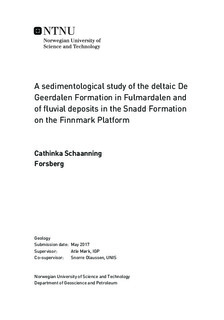A sedimentological study of the deltaic De Geerdalen Formation in Fulmardalen and of fluvial deposits in the Snadd Formation on the Finnmark Platform
Master thesis
Permanent lenke
http://hdl.handle.net/11250/2444276Utgivelsesdato
2017Metadata
Vis full innførselSamlinger
Sammendrag
In the Late Paleozoic, Svalbard and the Barents Sea were part of a large, shallow embaymentlocated at the north-western corner of the supercontinent Pangea. During the Triassic thisembayment was gradually filled with erosional products from the UralianMountains located insouth-east. A large delta systemevolved depositing the upper Triassic De Geerdalen and Snaddformations, on Svalbard and in the Barents Sea, respectively. This study investigates thesedimentology of the two formations, through fieldwork in Fulmardalen on Spitsbergen, andthrough investigations of a 3D seismic reflection cube and a sediment core from the FinnmarkPlatform in the south-western Barents Sea. The study aims to complement the understandingof the evolution of the delta systemthat evolved in the region during the Triassic.
Six sections were measured from different mountains in Fulmardalen. Facies analyses of theoutcrops indicate an overall shallowing upwards depositional environment, with open marineshelf and prodelta deposits in the lower part, shallow marine and delta front deposits in themiddle part and delta plain deposits in the upper part. This is concordant with previous studies of the formation. Laterally extensive and upwards coarsening sandstone unitswith sedimentary structures typically associated with wave- and tidal activity, characterize the shallow marine and delta front deposits in Fulmardalen. These units have been interpreted as barrier bars, forming as a result of low accommodation space allowing for basinal processes to rework the sediment.
The seismic investigation of the equivalent Snadd Formation on the Finnmark Platformreveals a much more fluvial dominated depositional environment compared to Fulmardalen. Arange of fluvial seismic geomorphological features have been interpreted, such as point-bardeposits from large meandering rivers, braided river morphologies with mid-channel-bars andsmaller ribbon shaped channel bodies. The sediment core, retrieved from a large point-barcomplex, shows characteristics typical of fluvial deposits. The channels show a generalWNW-ESE orientation, reflecting the overall progradation of the delta towards west andnorth-west. Width-to-thickness plots of selected channels compare well to plots of mainlymeandering rivers and distributaries from ancient and modern fluvial systems. Moreover,channel bodies in the lower part appear larger than channels further up in the formation. This trend is thought to be related to tectonic changes in the hinterland.
